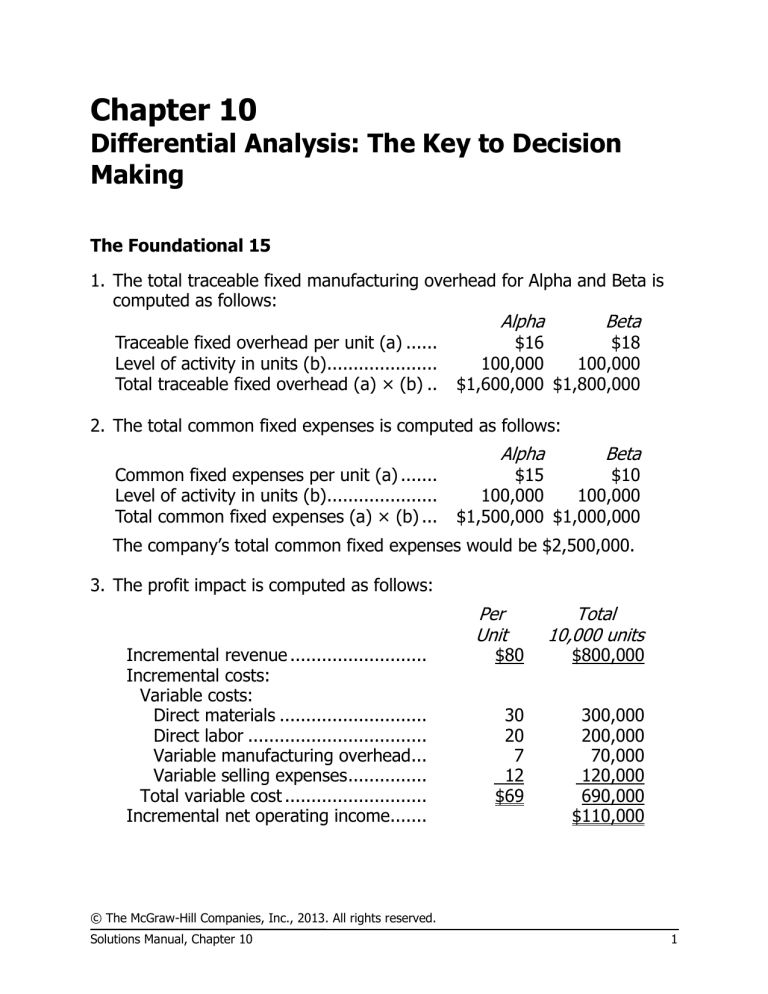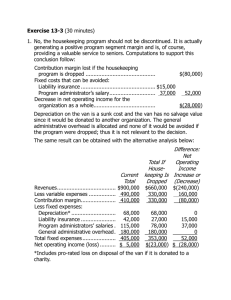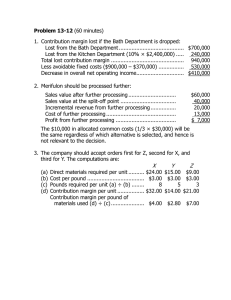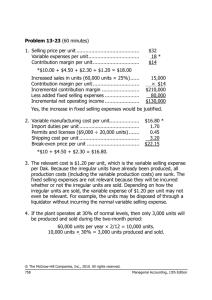
Chapter 10 Differential Analysis: The Key to Decision Making The Foundational 15 1. The total traceable fixed manufacturing overhead for Alpha and Beta is computed as follows: Traceable fixed overhead per unit (a) ...... Level of activity in units (b)..................... Total traceable fixed overhead (a) × (b) .. Alpha Beta $16 $18 100,000 100,000 $1,600,000 $1,800,000 2. The total common fixed expenses is computed as follows: Common fixed expenses per unit (a) ....... Level of activity in units (b)..................... Total common fixed expenses (a) × (b) ... Alpha Beta $15 $10 100,000 100,000 $1,500,000 $1,000,000 The company’s total common fixed expenses would be $2,500,000. 3. The profit impact is computed as follows: Incremental revenue .......................... Incremental costs: Variable costs: Direct materials ............................ Direct labor .................................. Variable manufacturing overhead... Variable selling expenses ............... Total variable cost ........................... Incremental net operating income....... Per Unit $80 30 20 7 12 $69 Total 10,000 units $800,000 300,000 200,000 70,000 120,000 690,000 $110,000 © The McGraw-Hill Companies, Inc., 2013. All rights reserved. Solutions Manual, Chapter 10 1 The Foundational 15 (continued) 4. The profit impact is computed as follows: Incremental revenue .......................... Incremental costs: Variable costs: Direct materials ............................ Direct labor .................................. Variable manufacturing overhead... Variable selling expenses ............... Total variable cost ........................... Incremental net operating income....... Per Unit $39 Total 5,000 units 12 15 5 8 $40 $195,000 60,000 75,000 25,000 40,000 200,000 $ (5,000) 5. The profit impact is computed as follows: Incremental revenue (10,000 units × $80) (a) ..................... Incremental variable costs: Direct materials (5,000 units × $30) . Direct labor (5,000 units × $20) ....... Variable manufacturing overhead (5,000 units × $7) ......................... Variable selling expenses (5,000 units × $12) ....................... Total incremental variable cost (b) ...... Foregone sales to regular customers (5,000 units × $120) (c) ..................... Incremental net operating income (a) − (b) – (c) .................................... $800,000 $150,000 100,000 35,000 60,000 345,000 600,000 $(145,000) Note to instructors: Emphasize to students that the variable costs related to 5,000 units of production are irrelevant to the decision because they will be incurred whether the special order is accepted or rejected. © The McGraw-Hill Companies, Inc., 2013. All rights reserved. Solutions Manual, Chapter 10 2 The Foundational 15 (continued) 6. The profit impact of dropping the Beta product line is computed as follows: Contribution margin lost if the Beta product line is dropped* .................................................................. $(3,600,000) Traceable fixed manufacturing overhead ........................ 1,800,000 Decrease in net operating income if Beta is dropped ...... $(1,800,000) * Beta’s contribution margin per unit is $40 ($80 − $40). Therefore, the decrease in contribution margin if Beta is dropped would be $3,600,000 (90,000 units × $40). Note to instructors: Emphasize that the traceable fixed manufacturing overhead is avoidable and the common fixed expenses are not. 7. The profit impact of dropping the Beta product line is computed as follows: Contribution margin lost if the Beta product line is dropped* .............................................................. Traceable fixed manufacturing overhead .................... Increase in net operating income if Beta is dropped ... $(1,600,000) 1,800,000 $ 200,000 * Beta’s contribution margin per unit is $40 ($80 − $40). Therefore, the decrease in contribution margin if Beta is dropped would be $1,600,000 (40,000 units × $40). 8. The profit impact of dropping the Beta product line is computed as follows: Contribution margin lost if the Beta product line is dropped ................................................................ Traceable fixed manufacturing overhead .................... Contribution margin on additional Alpha sales* .......... Increase in net operating income if Beta is dropped ... $(2,400,000) 1,800,000 765,000 $ 165,000 * Alpha’s contribution margin per unit is $51 ($120 − $69). Therefore, the increase in Alpha’s contribution margin if Beta is dropped would be $765,000 (15,000 units × $51). © The McGraw-Hill Companies, Inc., 2013. All rights reserved. Solutions Manual, Chapter 10 3 The Foundational 15 (continued) 9. The profit impact of buying 80,000 Alphas from a supplier rather than making them is computed as follows: Make Buy Cost of purchasing (80,000 units × $80)......... $6,400,000 Direct materials (80,000 units × $30) ............. $2,400,000 Direct labor (80,000 units × $20) ................... 1,600,000 Variable manufacturing overhead (80,000 units × $7) .................................... 560,000 Traceable fixed manufacturing overhead ......... 1,600,000 Total costs .................................................... $6,160,000 $6,400,000 Difference in favor of continuing to make the Alphas .................... $240,000 Note to instructors: Emphasize that the variable selling expenses are irrelevant to this decision because they will be incurred regardless of whether the company makes or buys its Alphas. 10. The profit impact of buying 50,000 Alphas from a supplier rather than making them is computed as follows: Make Buy Cost of purchasing (50,000 units × $80)......... $4,000,000 Direct materials (50,000 units × $30) ............. $1,500,000 Direct labor (50,000 units × $20) ................... 1,000,000 Variable manufacturing overhead (50,000 units × $7) .................................... 350,000 Traceable fixed manufacturing overhead ......... 1,600,000 Total costs .................................................... $4,450,000 $4,000,000 Difference in favor of buying Alphas from the supplier ..... $450,000 Note to instructors: Emphasize that the variable selling expenses are irrelevant to this decision because they will be incurred regardless of whether the company makes or buys its Alphas. © The McGraw-Hill Companies, Inc., 2013. All rights reserved. Solutions Manual, Chapter 10 4 The Foundational 15 (continued) 11. The pounds of raw material per unit are computed as follows: Alpha Direct material cost per unit (a) ......................... Cost per pound of direct materials (b) ................ Pounds of direct materials per unit (a) ÷ (b) ....... Beta $30 $6 5 $12 $6 2 12. The contribution margins per pound of raw materials are computed as follows: Selling price per unit ............................. Variable cost per unit ............................ Contribution margin per unit (a) ............ Pounds of direct material required to produce one unit (b) .......................... Contribution margin per pound (a) ÷ (b) Alpha Beta 5 pounds $10.20 2 pounds $20.00 $120 69 $ 51 $80 40 $40 13. The optimal number of units to produce would be computed as follows: Product Beta ................................... Alpha ................................. Total pounds available ......... Pounds Per Unit 2 5 Units Produced 60,000 8,000 Total Pounds 120,000 40,000 160,000 The company should produce Beta first because it earns the highest contribution margin per pound of raw materials. After customer demand for Beta has been satisfied by producing 60,000 units, there are 40,000 pounds of raw materials remaining to use for making Alphas. Since each Alpha requires 5 pounds of raw materials, the company would be able to produce 8,000 Alphas (40,000 pounds ÷ 5 pounds per unit) before running out of raw materials. © The McGraw-Hill Companies, Inc., 2013. All rights reserved. Solutions Manual, Chapter 10 5 The Foundational 15 (continued) 14. The total contribution margin would be computed as follows: Number of units produced (a) .................. Contribution margin per unit (b) .............. Total contribution margin (a) × (b) .......... Alpha Beta 8,000 60,000 $51 $40 $408,000 $2,400,000 The company’s total contribution margin would be $2,808,000 ($408,000 + $2,400,000). 15. The maximum price per pound is computed as follows: Regular direct material cost per pound ............................. Contribution margin per pound of direct materials ............. Maximum price to be paid per pound ............................... Alpha $ 6.00 10.20 $16.20 Because the company has satisfied all demand for Betas, it would use additional raw materials to produce Alphas. © The McGraw-Hill Companies, Inc., 2013. All rights reserved. Solutions Manual, Chapter 10 6 Exercise 10-1 (15 minutes) a. b. c. d. e. f. g. h. i. j. k. l. Item Sales revenue ................. Direct materials .............. Direct labor .................... Variable manufacturing overhead ..................... Book value—Model A3000 machine ............ Disposal value—Model A3000 machine ............ Depreciation—Model A3000 machine ............ Market value—Model B3800 machine (cost) .. Fixed manufacturing overhead ..................... Variable selling expense .. Fixed selling expense ...... General administrative overhead ..................... Case 1 Case 2 Not Relevant Relevant Not Relevant Relevant X X X X X X X X X X X X X X X X X X X X X X X X © The McGraw-Hill Companies, Inc., 2013. All rights reserved. Solutions Manual, Chapter 10 7 Exercise 10-2 (30 minutes) 1. No, the housekeeping program should not be discontinued. It is actually generating a positive program segment margin and is, of course, providing a valuable service to seniors. Computations to support this conclusion follow: Contribution margin lost if the housekeeping program is dropped .......................................... Fixed costs that can be avoided: Liability insurance ............................................. $15,000 Program administrator’s salary .......................... 37,000 Decrease in net operating income for the organization as a whole .................................... $(80,000) 52,000 $(28,000) Depreciation on the van is a sunk cost and the van has no salvage value since it would be donated to another organization. The general administrative overhead is allocated and none of it would be avoided if the program were dropped; thus it is not relevant to the decision. The same result can be obtained with the alternative analysis below: Revenues..................................... Variable expenses ........................ Contribution margin ..................... Fixed expenses: Depreciation* ............................ Liability insurance ...................... Program administrators’ salaries . General administrative overhead . Total fixed expenses ..................... Net operating income (loss) .......... Current Total $900,000 490,000 410,000 68,000 42,000 115,000 180,000 405,000 $ 5,000 Difference: Net Total If Operating HouseIncome keeping Is Increase or Dropped (Decrease) $660,000 330,000 330,000 $(240,000) 160,000 (80,000) 68,000 27,000 78,000 180,000 353,000 $(23,000) 0 15,000 37,000 0 52,000 $ (28,000) *Includes pro-rated loss on disposal of the van if it is donated to a charity. © The McGraw-Hill Companies, Inc., 2013. All rights reserved. Solutions Manual, Chapter 10 8 Exercise 10-2 (continued) 2. To give the administrator of the entire organization a clearer picture of the financial viability of each of the organization’s programs, the general administrative overhead should not be allocated. It is a common cost that should be deducted from the total program segment margin. Following the format introduced in an earlier chapter for a segmented income statement, a better income statement would be: Total Home Nursing Meals on Wheels Housekeeping Revenues............................ $900,000 $260,000 $400,000 $240,000 Variable expenses ............... 490,000 120,000 210,000 160,000 Contribution margin ............ 410,000 140,000 190,000 80,000 Traceable fixed expenses: Depreciation ..................... 68,000 8,000 40,000 20,000 Liability insurance ............. 42,000 20,000 7,000 15,000 Program administrators’ salaries.......................... 115,000 40,000 38,000 37,000 Total traceable fixed expenses ......................... 225,000 68,000 85,000 72,000 Program segment margins ... 185,000 $ 72,000 $105,000 $ 8,000 General administrative overhead ......................... 180,000 Net operating income (loss) . $ 5,000 © The McGraw-Hill Companies, Inc., 2013. All rights reserved. Solutions Manual, Chapter 10 9 Exercise 10-3 (30 minutes) 1. Cost of purchasing ....................... Direct materials............................ Direct labor.................................. Variable manufacturing overhead .. Fixed manufacturing overhead, traceable1.................................. Fixed manufacturing overhead, common ................................... Total costs ................................... Difference in favor of continuing to make the parts ...................... 1 Per Unit Differential Costs Make Buy $ 6 8 1 $20 2 0 $17 15,000 units Make Buy $ 90,000 120,000 15,000 $300,000 30,000 0 $20 0 0 $255,000 $300,000 $3 $45,000 Only the supervisory salaries can be avoided if the parts are purchased. The remaining book value of the special equipment is a sunk cost; hence, the $3 per unit depreciation expense is not relevant to this decision. Based on these data, the company should reject the offer and should continue to produce the parts internally. 2. Cost of purchasing (part 1) .......................... Cost of making (part 1) ............................... Opportunity cost—segment margin forgone on a potential new product line ................. Total cost.................................................... Difference in favor of purchasing from the outside supplier ........................................ Make Buy $255,000 $300,000 65,000 $320,000 $300,000 $20,000 Thus, the company should accept the offer and purchase the parts from the outside supplier. © The McGraw-Hill Companies, Inc., 2013. All rights reserved. Solutions Manual, Chapter 10 10 Problem 10-18A (30 minutes) 1. Contribution margin lost if the tour is discontinued .. Less tour costs that can be avoided if the tour is discontinued: Tour promotion ................................................ Fee, tour guide ................................................ Fuel for bus ..................................................... Overnight parking fee, bus ............................... Room & meals, bus driver and tour guide .......... Net decrease in profits if the tour is discontinued .... $(2,100) $600 700 125 50 175 1,650 $ (450) The following costs are not relevant to the decision: Cost Salary of bus driver Depreciation of bus Liability insurance, bus Bus maintenance & preparation Reason The drivers are all on salary and there would be no change in the number of drivers on the payroll. Depreciation due to wear and tear is negligible and there would be no change in the number of buses in the fleet. There would be no change in the number of buses in the fleet. There would be no change in the size of the maintenance & preparation staff. © The McGraw-Hill Companies, Inc., 2013. All rights reserved. Solutions Manual, Chapter 10 11 Problem 10-18A (continued) Alternative Solution: Keep the Tour Ticket revenue ................................. Less variable expenses ..................... Contribution margin ......................... Less tour expenses: Tour promotion.............................. Salary of bus driver........................ Fee, tour guide .............................. Fuel for bus ................................... Depreciation of bus........................ Liability insurance, bus ................... Overnight parking fee, bus ............. Room & meals, bus driver and tour guide ......................................... Bus maintenance and preparation... Total tour expenses .......................... Net operating loss ............................ $3,000 900 2,100 600 350 700 125 450 200 50 Difference: Net Operating Income Drop Increase or the Tour (Decrease) $ 0 0 0 0 350 0 0 450 200 0 175 0 300 300 2,950 1,300 $ (850) $(1,300) $(3,000) 900 (2,100) 600 0 700 125 0 0 50 175 0 1,650 $ (450) 2. The goal of increasing average seat occupancy could be accomplished by dropping tours like the Historic Mansions tour with lower-thanaverage seat occupancies. This could reduce profits in at least two ways. First, the tours that are eliminated could have contribution margins that exceed their avoidable costs (such as in the case of the “Historic Mansions” tour in part 1). If so, then eliminating these tours would reduce the company’s total contribution margin more than it would reduce total costs, and profits would decline. Second, these tours might be acting as “magnets” that draw tourists to other, more profitable tours. © The McGraw-Hill Companies, Inc., 2013. All rights reserved. Solutions Manual, Chapter 10 12 Problem 10-19A (15 minutes) 1. Revenue from further processing: Selling price of one filet mignon (6 ounces × $3.60 per pound/16 ounces per pound) ........................... Selling price of one New York cut (8 ounces × $2.90 per pound/16 ounces per pound) ........................... Total revenue from further processing ......................... Less revenue from one T-bone steak ........................... Incremental revenue from further processing ............... Less cost of further processing .................................... Profit per pound from further processing ..................... Per 16-Ounce T-Bone $1.35 1.45 2.80 2.25 0.55 0.20 $0.35 2. The T-bone steaks should be processed further into filet mignon and the New York cuts. This will yield $0.35 per pound in added profit for the company. The $0.55 “profit” per pound for T-bone steak mentioned in the problem statement is not relevant to the decision because it contains allocated joint costs. The company will incur the allocated joint costs regardless of whether the T-bone steaks are sold outright or processed further; thus, this cost should be ignored in the decision. © The McGraw-Hill Companies, Inc., 2013. All rights reserved. Solutions Manual, Chapter 10 13 Problem 10-21A (30 minutes) 1. Incremental revenue: Fixed fee (10,000 pairs × €4 per pair) ............. Reimbursement for costs of production: (Variable production cost of €16 plus fixed overhead cost of €5 equals €21 per pair; 10,000 pairs × €21 per pair) ......................... Total incremental revenue ............................... Incremental costs: Variable production costs (10,000 pairs × €16 per pair) ...................................................... Increase in net operating income ....................... 2. Sales revenue through regular channels (10,000 pairs × €32 per pair)* ........................ Sales revenue from the army (above) ................. Decrease in revenue received ............................ Less variable selling expenses avoided if the army’s offer is accepted (10,000 pairs × €2 per pair) .............................................................. Net decrease in net operating income with the army’s offer .................................................... € 40,000 210,000 250,000 160,000 € 90,000 €320,000 250,000 70,000 20,000 € 50,000 *This assumes that the sales through regular channels can be recovered after the special order has been fulfilled. This may not happen if regular customers who are turned away to fill the special order are permanently lost to competitors. © The McGraw-Hill Companies, Inc., 2013. All rights reserved. Solutions Manual, Chapter 10 14 © The McGraw-Hill Companies, Inc., 2013. All rights reserved. Solutions Manual, Chapter 10 15






